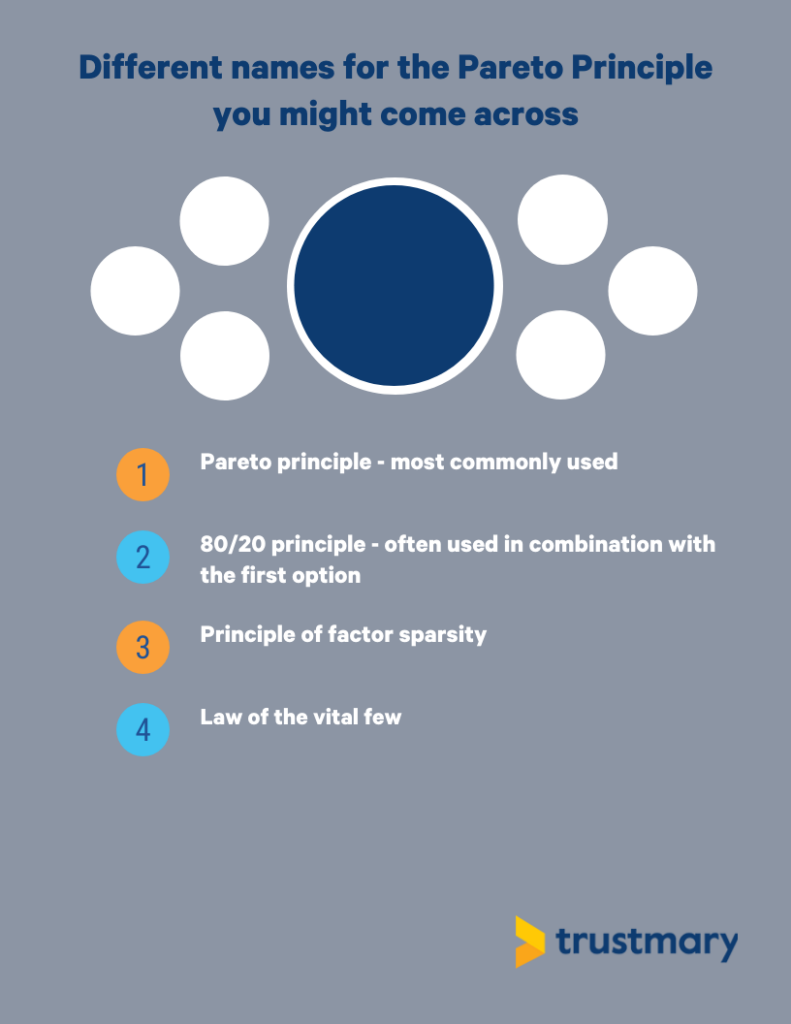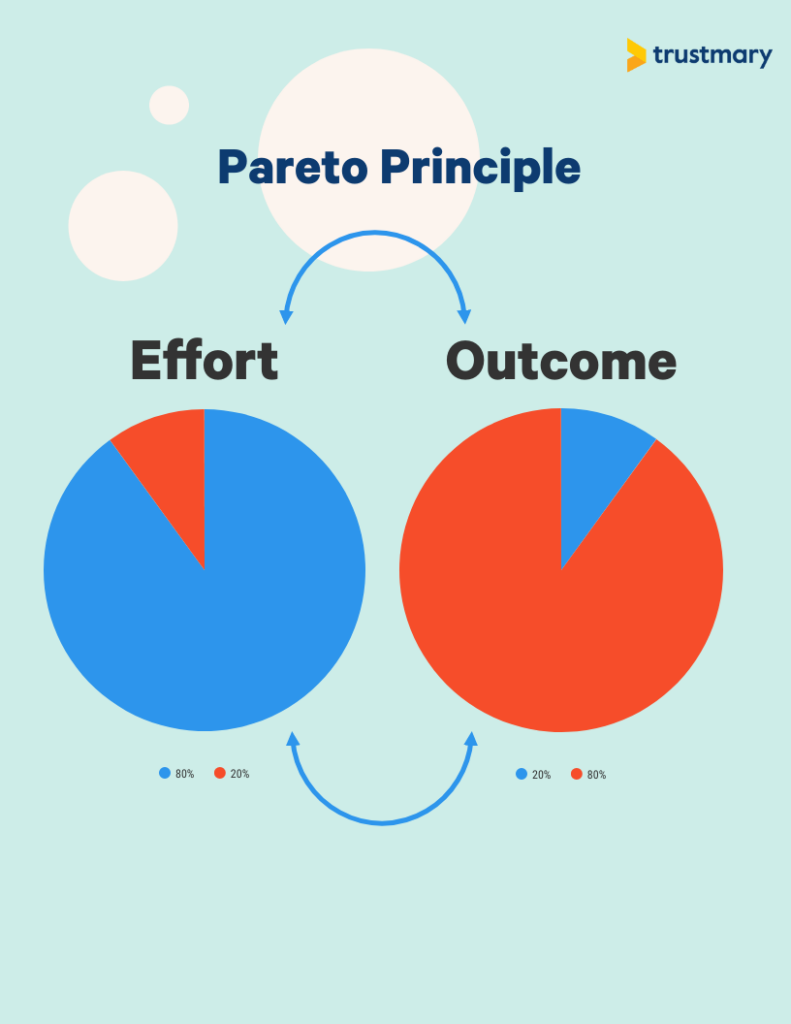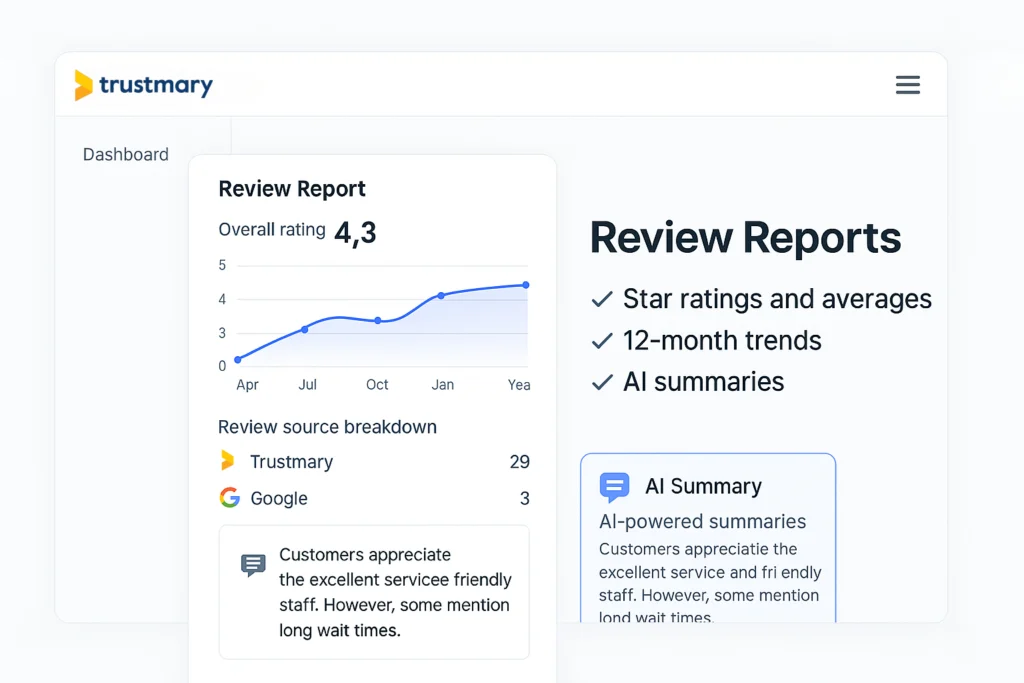Examples and Definition of the 80/20 Pareto Principle


Whether you’re running marketing campaigns, managing customer relationships, or steering business strategy, one thing’s clear: not everything you do delivers equal results.
Some actions move the needle, a lot while most don’t.
That’s where the Pareto Principle, or the 80/20 rule, changes the game. It helps you zero in on the small percentage of efforts that generate the biggest impact across your organization.
- In marketing, 20% of campaigns might generate 80% of leads.
- In customer success, 20% of issues may cause 80% of churn.
- For business leaders, 20% of customers often drive 80% of revenue.
Recognizing these patterns means you can work smarter, not harder. And with tools like Trustmary, it’s easier than ever to put this principle into action. From collecting powerful testimonials to surfacing insights that help you prioritize your time, Trustmary helps you do more of what works.
In this article, we’ll explore how applying the 80/20 mindset across different parts of your business can lead to better decisions, improved outcomes, and less stress.
Let’s dive into what the Pareto Principle really means, and how you can start using it to grow with intention.
Understanding the Pareto Principle
Also known as the 80/20 rule, the Pareto principle explains the connection between actions and consequences. This phenomenon is known by several other names, such as the principle of factor sparsity.
Let’s take a look at all of them.

History of Pareto Principle
The Pareto Principle was first used in the field of macroeconomics in the beginning of the 20th century. The person that introduced it to the world was an Italian economist Vilfredo Pareto who came up with the concepts known as Pareto Efficiency in 1906.
While these numbers aren’t always accurate, they give people a nice perspective into the causation process. The Italian economist founded the 80/20 rule after detecting that 20% of the pea pods in the garden he owned were responsible for 80% of all the peas he grew.
As Vilfredo Pareto noticed this, he decided to expand it into macroeconomics, he decided to use it to check wealth distribution. He soon realized that only 20% of the Italian population owned 80% of the wealth of Italy.
That’s when it all began.
How the 80/20 Rule Applies to Marketing
The Pareto Principle suggests that roughly 80% of outcomes come from 20% of the causes.
While the exact numbers aren’t set in stone (it could be 70/30 or even 90/10), the key idea is that a small portion of inputs typically leads to the majority of outputs.
Let’s visualize this concept so that you can understand it better.

In the business world, the goal of the 80/20 rule is to tell you which inputs have the highest potential for the majority of outputs so that you can prioritize them.
- 20% of campaigns drive 80% of results
- 20% of channels bring 80% of traffic
- 20% of content generates 80% of engagement
- 20% of customers produce 80% of revenue
Why Pareto Principle Matters for Marketing Teams
If you're a marketer wearing multiple hats, you know that time and attention are finite resources.
Applying the Pareto Principle helps you:
- Focus on high-impact activities
- Avoid wasting time on low-yield tasks
- Improve your marketing ROI
- Create leaner, more effective campaigns
- Get better results with less effort
This isn’t about doing less—it’s about doing the right things more often.
When you identify which root causes lead to better results, you'll be able to see through the noise and focus on what matters most.
What the 80/20 Rule Means for Customer Success
In customer success, the 80/20 rule typically reveals that:
- 20% of customers generate 80% of revenue
- 20% of customers cause 80% of support tickets or churn risk
- 20% of product features drive 80% of user satisfaction
- 20% of engagement actions lead to 80% of retention and expansion
The core idea? Not all customers or activities have equal impact, so teams should identify and focus on the vital few.
1. Focus on High-Value Customers (The Revenue-Driving 20%)
In many SaaS or subscription-based businesses, a small portion of the customer base—usually around 20%—is responsible for a significant chunk (often 80% or more) of revenue, upsells, renewals, and referrals.
These aren’t just your highest-paying customers. They’re also the ones who:
- Use your product regularly and effectively
- Advocate for your brand on social media and in communities
- Are open to new features or early access programs
- Provide high-quality reviews and testimonials
- Refer peers or bring new users via word-of-mouth
Why This Matters for Customer Success
Time and bandwidth are limited. Trying to give every customer equal attention may seem fair, but it's rarely strategic. By identifying and focusing efforts on your most valuable accounts, you can deepen relationships that generate the most long-term value for your business.
These customers are your power users, your case study material, and often your best source of expansion revenue.
What You Can Do:
- Segment Your Customer Base
- Use filters like plan tier, ARR, feature usage, and NPS score.
- Highlight accounts that score high across revenue, product engagement, and advocacy potential.
- Create a Strategic Success Plan for Top Accounts
- Assign a dedicated Customer Success Manager or account owner.
- Schedule quarterly business reviews (QBRs) or strategic check-ins.
- Share personalized success resources (custom dashboards, industry benchmarks, optimization tips).
- Turn Advocates into Assets
- Ask for testimonials or case studies from your top 20% happiest customers.
- Encourage them to post reviews on G2, Capterra, or Google.
- Automate post-onboarding or milestone-based review requests using a platform like Trustmary.
- Build Loyalty Loops
- Invite them to beta test new features.
- Offer VIP access to webinars, events, or product roadmaps.
- Celebrate their wins publicly (e.g. social shoutouts or blog features).
The Pareto Principle and Customer Satisfaction: Focus on What Matters Most
Here’s the secret: boosting customer satisfaction doesn’t have to mean overhauling everything.
Often, just 20% of your efforts can drive 80% of your customers’ happiness—especially when it comes to how you collect and showcase feedback.
Start with the 20% That Has the Biggest Impact
If customer testimonials and reviews bring in the majority of your leads (and they usually do), then improving how you collect, manage, and display those testimonials is one of the smartest moves you can make.
That’s where Trustmary comes in. It helps you:
- Automate testimonial collection at key touchpoints
- Turn happy customers into public advocates
- Add reviews directly to your website to build trust and boost conversions
Want to see the results for yourself? Book a free demo and experience how easy it is to collect reviews that actually move the needle.
Let Your Happy Customers Speak for You
People trust other people. When potential buyers see that others are satisfied with your product or service, it lowers the risk and builds credibility. With the right tools, you can:
- Encourage satisfied customers to share their experience publicly
- Turn NPS promoters into 5-star reviewers
- Display top reviews where they matter most—landing pages, product pages, and emails
With Trustmary, this process is automatic, seamless, and measurable.
Measure and Optimize Based on Real Feedback
Want to know what’s actually working? Trustmary provides insightful reports that show you:
- Which reviews are getting seen and clicked
- How many new leads your testimonials generate
- What kind of sentiment your brand is creating online
This feedback loop helps you spot and fix issues before they turn into churn, and celebrate what’s working with confidence.
Eliminate Dissatisfaction with Smart Prioritization
The Pareto Principle teaches us to focus on the few areas that cause most problems. With Trustmary’s data, you can quickly pinpoint:
- Which customer segments are most at risk
- What types of feedback indicate dissatisfaction
- Where to act to improve retention
By combining smart tools with Pareto thinking, you can reduce complaints, improve satisfaction, and build a stronger reputation, without spreading your team too thin.

Smarter Decision Making with the 80/20 Rule
One of the most powerful applications of the Pareto Principle is in decision-making and problem-solving.
Instead of trying to solve every issue at once, the 80/20 rule helps you focus on the few problems that cause the majority of negative outcomes.
Let’s face it—businesses deal with endless variables. But not all problems deserve equal attention. The 80/20 approach helps you cut through the noise and prioritize what will make the biggest difference.
Here’s how to apply it in a structured, actionable way:
Step-by-Step: Apply the 80/20 Rule to Any Business Problem
- Clarify the core problems you want to solve
Whether it’s declining conversions, churn, or a drop in customer engagement, get specific about what’s going wrong. - Identify the root causes
Dig into your analytics, feedback, or CRM data. Tools like Trustmary can help uncover customer sentiment trends that highlight root causes. - Group problems into logical categories
For example: onboarding issues, product confusion, lack of social proof, or pricing friction. If something overlaps, it’s okay to assign it to multiple categories. - Score each problem by business impact
Rate each item on a simple scale (e.g., 1–10) based on how much it affects your KPIs, like revenue, customer churn, or customer satisfaction. - Focus on the top 20% with the highest scores
Prioritize problems that—if solved—would improve several areas at once. These are your high-leverage opportunities.
For instance, resolving poor review visibility could boost trust, increase conversions, and reduce bounce rates.
Prioritize Like a Pro: Let Data Tell You Where to Focus
The Pareto Principle will show you how the minority of inputs create the majority of results. More importantly, it will help you determine what or who is the minority so you can prioritize it.
If 20% of your workers contribute 80 percent of the company’s results and you know who those workers are, it’s best to reward and motivate them the most.
If 80% of crashes in your system occur because of 20% of bugs, isn’t it best to know which bugs are the biggest problem and remove them first?
This goes on and on, and while it only refers to a typical distribution, this principle has shown tremendous success over the years. It is even theorized to be a natural law.
Regardless of its definitions, Pareto’s principle can help you improve the future of your business and potentially generate more income.
Why not put in the effort and give it a test run, then?
FAQ
What are the main reasons to use Pareto analysis?
Pareto analysis is a simple technique to facilitate your decision-making process. The data you get with it helps you assess a variety of problems, prioritize the tasks, and leads to better time management.
Can I really use the Pareto Principle to reduce stress?
Many people use the Pareto analysis to manage their time more efficiently and reduce stress as a result.